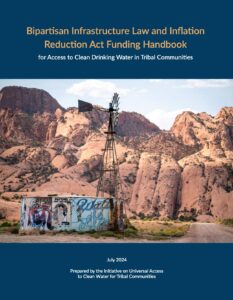Congress set aside substantial sums of money in 2021 and ’22 in the Bipartisan Infrastructure Law and the Inflation Reduction Act to address needs for access to safe, clean drinking water. But, as John Echohawk puts it:
While the appropriation of funding for infrastructure is a critical first step, it is only that – continuing and concerted efforts must be made to ensure that Tribal communities are able to access and deploy this funding and that meaningful gains are made in reducing the water access gap in Indian country.
Echohawk makes those comments in the introduction to the new Handbook from the Universal Access to Clean Water for Tribal Communities project, out today. The challenge now is for Tribal communities to navigate the complexities of federal funding process which are, to see the least, a significant challenge.
We’ve written about this challenge before in this space – a staggering 48 percent of tribal homes, according to the Universal Access project’s analysis, lack access to reliable water sources, clean drinking water, or basic sanitation. Money helps, but getting the money to the communities that might benefit requires negotiating a maze of federal process.
The new handbook (link to the handbook and a summary document here) outlines the many different pathways and requirements to translate Congressional intent to water projects on the ground.
The report is crucial for helping move down the path. Also, bonus points to the team that put it together for the stunning Tara Kerzhner photos.

